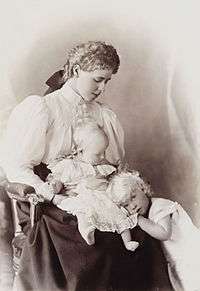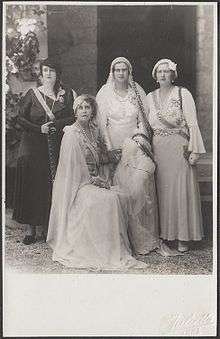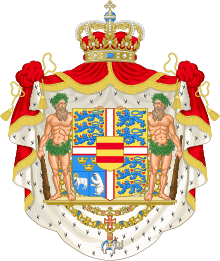Elisabeth of Romania
| Elisabeth | |||||
|---|---|---|---|---|---|
 | |||||
| Queen consort of the Hellenes | |||||
| Tenure | 27 September 1922 – 25 March 1924 | ||||
| Born |
12 October 1894 Peleş Castle, Sinaia, Romania | ||||
| Died |
14 November 1956 (aged 62) Cannes, France | ||||
| Burial | Hedinger Church, Sigmaringen, Baden-Wurttemberg, West Germany | ||||
| Spouse |
George II of Greece (m. 1921 – div. 1935) | ||||
| |||||
| House | Hohenzollern-Sigmaringen | ||||
| Father | Ferdinand of Romania | ||||
| Mother | Princess Marie of Edinburgh | ||||
| Religion | Eastern Orthodox | ||||
Elisabeth of Romania (full name Elisabetha Charlotte Josephine Alexandra Victoria: Romanian: Elisabeta a României, Greek: Ελισάβετ της Ρουμανίας; 12 October 1894 – 14 November 1956) was a princess of Romania and member of the House of Hohenzollern-Sigmaringen and by marriage Queen consort of the Hellenes during 1922–1924.
Raised by her great-uncle King Carol I of Romania and his wife Queen Elisabeth of Wied, she developed an introverted character which socially isolated her. Married to the heir to the Greek throne in 1921, she felt no passion for him and suffered the political turmoil that crossed her adopted country after the World War I. After her husband became King of Greece in 1922, Elisabeth was involved in assisting refugees who arrived to Athens after the disaster of the Greco-Turkish War. The rise of the revolutionary climate, however, affected her health and with great relief she left the Kingdom of Greece with her husband in December 1923. The royal couple then settled in Bucharest, where eventually King George II was deposed on 25 March 1924.
In Romania, Elisabeth and George II's relationship deteriorated and eventually the couple divorced in 1935. Very close to her brother, King Carol II of Romania, the princess amassed an important fortune, partly due to financial advice of her lover, the banker Alexandru Scavani. After the death of her mother, Queen Marie, in 1938 and the dethronement of Carol II in 1940, Elisabeth took the role of First Lady of Romania. At the end of World War II, she established close links with the Romanian Communist Party and openly conspired against her nephew, the young King Michael I, earning the nickname of "Red Aunt" of the sovereign. However, her communist links didn't save her from being expelled from the country when was proclaimed the Socialist Republic of Romania in 1947. Exiled, the princess moved to Switzerland and then to Cannes, in southern France. She had a romantic relationship with Marc Favrat, a man almost thirty years younger, whom she finally adopted just before her death in 1956.
Life
Youth
Early years

Second child and first daughter of Crown Prince Ferdinand and Crown Princess Marie of Romania (a member of the British royal family and later Princess of Saxe-Coburg and Gotha), Elisabeth (nicknamed Lisabetha or Lizzy by her family) was born on 12 October 1894 at Peleş Castle, Sinaia.[1] Named after her paternal great-aunt, Queen Elisabeth of Wied,[2] shortly after birth she was removed from her parents. With her older brother Prince Carol, she was raised by King Carol I and his wife.[3][4] Over the years, Elisabeth develops a cold character and a volatile temperament, who socially isolated her. Considered "vulgar" by her mother, however, she has the reputation of being a classical beauty.[1]
An undesired engagement
From 1911, the Greek and Romanian governments approach for geopolitical reasons and Prince George of Greece, then second-in-line to the throne, and her second cousin, met Elisabeth for the first time.[5] After the Balkan Wars, during which Greece and Romania are allied, the Greek prince asks for the hand of Elisabeth, but, advised by her great-aunt, she declined the offer, saying that her suitor was too small and too English in his manners. Disdainful, the princess even says on this occasion, that "God began the prince but forgot to finish him" (1914).[6][7]
During World War I, Elizabeth is involved in helping wounded soldiers. She made daily visits to the hospitals and distributes cigarettes and comforting words to the victims of the fighting.[8]
In 1919, Elisabeth and her sisters Maria and Ileana accompany their mother, now Queen Marie, to Paris at the Peace Conference. The sovereign hope that during her stay there she could find suitable husbands for her daughters, especially Elisabeth, already aged twenty-five.[9] After a few months in France, the Queen and her daughters decided to return to Romania in early 1920. On the way back, they made a brief stop in Switzerland, where they found the Greek royal family, who lives in exile since the deposition of King Constantine I during the Great War. Elisabeth then finds again Prince George (now Diadochos and heir of the throne), who asks again her hand. Now more aware of her own imperfections (her mother described her as fat and of very limited intelligence), Elisabeth decides to accept the marriage. However, at that time the future of the Diadochos was far from certain: displaced from the throne with his father and replaced by his younger brother, now King Alexander I, George was forbidden to stay in his country, penniless and without any condition.[5][10]
Nevertheless, the engagement satisfies both Elisabeth and George's parents. Delighted to have finally found a husband for her eldest daughter, the Queen of Romania soon invite the prince to travel to Bucharest in order to publicly announce the engagement.[10] George agrees but soon after his arrival in the country of his fiancée, he learned of the accidental death of Alexander I and the ensuing political turmoil that erupted in Greece.[11][12]
Life in Greece
Restoration of the Greek royal family. Wedding of George and Elisabeth

On 5 December 1920 a referendum of disputed results[lower-alpha 1] called the Greek royal family to return home.[13] King Constantine I, Queen Sophia and Diadochos George therefore return to Athens on 19 December. Their return was accompanied by a significant jubilation. A huge crowd surrounded the sovereign and the heir to the throne through the streets of the capital. Once at the palace, they must appear repeatedly on the balcony to greet the people who cheered them.[14][15]
However, a few weeks later George returns to Romania to marry Elisabeth. The wedding took place with great pomp in Bucharest on 27 February 1921. Shortly after, Crown Prince Carol of Romania, Elisabeth's older elder brother, marry with George's younger sister, Princess Helen of Greece.[1][11][16]
An isolated crown princess
In Greece, Elisabeth had great difficulty to integrate into the royal family, and her relationship with Queen Sophia was particularly awkward.[1][17] From an introverted temperament that could be mistaken as arrogance,[18][19] Elisabeth feels displaced by her in-law, who regularly talk in Greek in her presence, becaue she has not yet mastered the language.[1][20] Only King Constantine I and his sister, the Grand Duchess Maria Georgievna of Russia, found favor in her eyes.[1][19] Indeed, even the shy Diadochos disappoint his wife, who wanted to share with him a more passionate relationship.[21][22]
Regretting not having her own home and being forced to constantly live with her in-laws, Elisabeth spent the already little revenues of her husband into redecorating their apartments. In addition, her family delayed in pay her dowry[21] and the savings that she left in Romania were soon lose because of the poor investments made by the manager of her fortune.[23]
Facing a very difficult political situation, due to the Greco-Turkish War, Elisabeth quickly understood that her space for maneuver was limited in her new country. However, she integrated the Red Cross, which was overwhelmed by the arrival of wounded coming from Anatolia.[19][24] The Crown Princess also occupies her free time practicing gardening, painting and drawing. She thus illustrates a book of poems written by the Belgian author Emile Verhaeren. She also likes writing and producing some new books of low value.[21][25] Finally, she spends long hours studying the Modern Greek, a language that was extremely hard for her to learn.[23]
Disappointed by the mediocrity of her daily routine, Elisabeth began to nourish jealousy for her sister Maria, married to King Alexander I of Yugoslavia, and her sister-in-law Helen of Greece, wife of her brother Crown Prince Carol of Romania.[21][26] With the war and the revolution, the everyday life of the Greek royal family was indeed increasingly difficult, and the pension received by the Diadochos George didn't allow her to buy the clothes and jewelry that she wanted.[21]
Already strained by the war, the relations of the Diadochos and his wife were clouded by their inability to give an heir to the Kingdom of Greece. Elisabeth became pregnant a few months after her marriage, but she suffered a miscarriage during an official trip to Smyrna.[lower-alpha 2] Deeply affected by her miscarriage, the crown princess became sick with typhoid soon followed by pleurisy and worsened by depression. She found refuge with her family in Bucharest, but despite the efforts of her mother and husband, neither Elisabeth's health nor her marriage fully recovered from the loss of her child.[29][30][31]
Queen of the Hellenes
Meanwhile, the disaster of the Greco-Turkish War forced King Constantine I to abdicate, which pushes George and Elisabeth on the throne (27 September 1922).[30] The new rulers, however, have no power, and they attend with impotence to the repression organized by the revolutionaries who took power against the representatives of the old regime. The new royal couple saw with anguish the near execution of Prince Andrew at the Trial of the Six.[32][33]
Despite this difficult context, Elisabeth tries to make herself useful to her adopted country. To respond to the influx of refugees originating from Anatolia, the Queen had built shacks on the outskirts of Athens. To carry out her projects, she mobilizes her family and asked her mother, Queen Marie, to send wood and other materials.[32][34]
However, Elisabeth was increasingly difficult to cope with Greece and its revolutionary climate. Her love for George II was over and her letters to her mother show how much she worried for her future.[34][35] Her correspondence also reveals that she has no desire to have children.[36]
After an attempted monarchist coup d'état in October 1923, the situation of the royal couple became even more precarious. On 19 December 1923 King George II and his wife were forced into exile by the revolutionary government. With Prince Paul, they then depart for Romania, where they learn of the proclamation of the Second Hellenic Republic on 25 March 1924.[37][38][39]
Return to Romania
Queen in exile

In Romania, George II and Elizabeth moved to Bucharest, where King Ferdinand I and Queen Marie gave to them a wing of Cotroceni Palace. After a few weeks, the couple moved up to a modest villa in the Calea Victoriei. Regular guests Romanian sovereigns, the exiled Greek royal couple participate in court ceremonies. But despite the kindness with which treats by his mother-in-law, the exiled King of Greece in Bucharest feels aimless and barely conceal the boredom that he felt at the Romanian court.[37][40][41]
Unlike her husband, Elisabeth was delighted with her return to Romania. Her relationship with her mother was yet sometimes stormy, even if their literary collaboration was successful. In the mid 1920s, Elisabeth illustrated the latest work of her mother, The Country That I Love (1925).[lower-alpha 3][42] The links with Crown Princess Helen of Romania (wife of Crown Prince Carol of Romania and sister of King George II of Greece) remained complicated due to the jealousy that the exiled Queen of the Hellenes still continues to feel against her sister-in-law.[43]
Exarcebated by the humiliations of exile, financial difficulties and the lack of offspring, the relations between George II and Elisabeth deteriorate. After initially misled her weariness with too much rich food and gambling, the former Queen of the Hellenes began a series of extramarital relationships with several married men. She even flirts with her brother-in-law King Alexander I of Yugoslavia when she visit her sister Queen Maria during an illness in Belgrade. Later, she enters into an affair with the banker of her husband, a Greek-Romanian named Alexandru Scavani, which was appointed her chamberlain to cover up the scandal. However, Elisabeth is not the only one responsible for the failure of her marriage: over the years, George II spend less time with his wife and gradually settled his residence in the United Kingdom, where he also enters into an adulterous relationship.[44][45][46][47]
In May 1935, Elisabeth heard from a Greek diplomat that the Second Hellenic Republic was on the verge of collapse and that the restoration of the monarchy is imminent in Greece.[47] Frightened by this news, the exiled Queen of the Hellenes then launched divorce proceedings without telling her husband. Charged with "desertion from the family home", George II saw his marriage dissolved by a Bucharest court without being really invited to speak on the matter (6 July 1935).[37][46][47][48][49]
An ambitious princess

After the death of King Ferdinand I in 1927, Romania began a period of great instability. After Crown Prince Carol resigned his rights to be able to live with his mistress Magda Lupescu, his son ascended to the throne as King Michael I under the direction of a Council of Regency.[50] Nevertheless, a significant part of the population supports the rights of Carol,[51] who finally manages to take the crown in 1930.[52] Very close to her brother, she actively supports his return to Romania, Elisabeth kept him daily informed of the country's political life during his years of exile.[53]
Once on the throne, Carol II maintains stormy relations with the members of his family but retains his confidence in Elisabeth, which was the only member of the royal family who accepted his mistress.[54] Thanks to the inheritance received from her father,[55] the financial advices of her lover, the banker Alexandru Scavani, and her good relations with her brother, the princess manages to live in great style in Romania.[56][57] In March 1935, she acquires the large domain of Banloc, near the border with Yugoslavia, a mansion in Sinaia and an elegant villa of Italian style, the called Elisabeta Palace, located in the Șoseaua Kiseleff in Bucharest.[56]
After the death of the Queen Mother Marie in 1938 and to the deposition of Carol II in 1940, Elisabeth plays the role of First Lady of Romania. Ambitious, the princess has indeed no remorse to follow her brother's policy, even when she shows herself tyrannical with other members of the royal family.[58] After the return to the throne of Michael I and the establishment of the dictatorship of Marshal Ion Antonescu, Elisabeth stayed out from politics.[59] However, from 1944, she forges links with the Romanian Communist Party and openly conspire against her nephew, who now considers her a spy.[58][60][61] In early 1947, she received in her domain of Banloc the Marshal Tito, who deposed another of her nephews, the young King Peter II of Yugoslavia.[62][63] Finally, through Alexandru Scavani, the Princess participates in the financing of the guerrilla who fought against her former brother-in-law, the now King Paul I, in Greece.[58]
However, Elisabeth wasn't the only member of the Romanian royal family who had friendly relations with the communists: her sister Ileana did the same in the hope of put her eldest son, Archduke Stefan of Austria, on the throne. For all these reasons, the two princesses then receive the nickname of "Red Aunts" of King Michael I.[64]
Last years
Despite her links with the Romanian Communist Party, Elisabeth was forced to leave the country after the proclamation of the Socialist Republic of Romania, on 30 December 1947. The new regime gives her three days to pack her belongings and the Elisabeta Palace was ransacked. However, before she went into exile, the princess has time to burn her archives in the domain of Banloc.[58] On 12 January 1948 she left Romania with her sister Ileana aboard a special train provided by the Communists. The Scavani family accompanied them, but both princesses lost much of their property after being expelled from the country.[65]

Elisabeth settled firstly in Zurich and then in Cannes, at the Villa Rose Alba. In France, she met a handsome young seducer called Marc Favrat.[lower-alpha 4] Having fallen in love of the young man, the princess asks her cousin, Frederick, Prince of Hohenzollern, a title for him, but he refused. The princess then took the decision to adopt her lover; she made it three months before her death. She died at her home on 14 November 1956.[66][67]
The body of the princess was transferred to the Hohenzollern-Sigmaringen crypt, the Hedinger Kirche of Sigmaringen.[68]
Ancestry
Arms and monogram
 |
 |
 |
Notes
- ↑ 99% of voters would cast in favor of the deposed sovereign.[13]
- ↑ In his biography of Elisabeth, John Wimbles doesn't mention this pregnancy and the miscarriage that followed. Other authors, like Michael Darlow, have a very different theory of this event. According to them, the Crown Princess became pregnant after an affair with the British diplomat Frank Rattigan, and the miscarriage was merely a disguised abortion to prevent the birth of an illegitimate child.[27][28]
- ↑ See the illustrations in: The Country That I Love by Marie Queen of Rumania [retrieved 20 July 2016].
- ↑ According to the American biographer Marlene Eilers Koenig, Marc Favrat was born in Paris on 8 March 1924 and died in the same city on 5 March 2000. See: Marlene Eilers Koenig, How Did Elisabeta meet Marc Favrat? in: Royal Musings [retrieved 20 July 2016].
References
- 1 2 3 4 5 6 Mateos Sainz de Medrano 2004, p. 183.
- ↑ Marcou 2002, p. 42.
- ↑ Gelardi 2006, p. 76.
- ↑ Marcou 2002, p. 43.
- 1 2 Marcou 2002, p. 122.
- ↑ Queen Marie of Romania 2006, p. 61.
- ↑ Van der Kiste 1994, p. 121.
- ↑ Wimbles 2002, p. 137 and 140.
- ↑ Marcou 2002, p. 112.
- 1 2 Van der Kiste 1994, p. 122.
- 1 2 Van der Kiste 1994, p. 130.
- ↑ Marcou 2002, pp. 117–118.
- 1 2 Van der Kiste 1994, p. 126.
- ↑ Van der Kiste 1994, pp. 128–129.
- ↑ Gelardi 2006, pp. 295–296.
- ↑ Palmer and Greece 1990, p. 63.
- ↑ Wimbles 2002, p. 136, 138 and 141.
- ↑ Gelardi 2006, p. 309.
- 1 2 3 Wimbles 2002, p. 137.
- ↑ Wimbles 2002, p. 136.
- 1 2 3 4 5 Mateos Sainz de Medrano 2004, p. 185.
- ↑ Wimbles 2002, p. 137–138.
- 1 2 Wimbles 2002, p. 138.
- ↑ Mateos Sainz de Medrano 2004, p. 184.
- ↑ Wimbles 2002, p. 139.
- ↑ Wimbles 2002, p. 140 and 141–142.
- ↑ Michael Darlow, Terence Rattigan: The Man and his Work, Quartet Books 2010, p. 51.
- ↑ Geoffrey Wansell, Terence Rattigan (London: Fourth Estate, 1995) ISBN 978-1-85702-201-8
- ↑ Palmer and Greece 1990, p. 65.
- 1 2 Mateos Sainz de Medrano 2004, pp. 185–186.
- ↑ Van der Kiste 1994, p. 138.
- 1 2 Mateos Sainz de Medrano 2004, p. 186.
- ↑ Wimbles 2002, p. 168.
- 1 2 Wimbles 2002, p. 169
- ↑ Mateos Sainz de Medrano 2004, p. 186–187.
- ↑ Wimbles 2002, p. 171.
- 1 2 3 Mateos Sainz de Medrano 2004, p. 187.
- ↑ Van der Kiste 1994, p. 144.
- ↑ Wimbles 2002, pp. 173–174.
- ↑ Van der Kiste 1994, p. 145 and 148.
- ↑ Gelardi 2006, p. 310.
- ↑ Wimbles 2003, p. 200.
- ↑ Wimbles 2003, p. 203.
- ↑ Mateos Sainz de Medrano 2004, pp. 187–188.
- ↑ Van der Kiste 1994, p. 145.
- 1 2 Vickers 2000, p. 263
- 1 2 3 Wimbles 2003, p. 204.
- ↑ Palmer and Greece 1990, p. 70.
- ↑ Van der Kiste 1994, p. 151.
- ↑ Marcou 2002, pp. 144–146.
- ↑ Marcou 2002, pp. 156–164.
- ↑ Marcou 2002, p. 197.
- ↑ Marcou 2002, p. 164, 172 and 197.
- ↑ Marcou 2002, pp. 222–223.
- ↑ Wimbles 2003, p. 202.
- 1 2 Mateos Sainz de Medrano 2004, p. 191.
- ↑ Gelardi 2006, pp. 361–362.
- 1 2 3 4 Mateos Sainz de Medrano 2004, p. 192
- ↑ Wimbles 2003, pp. 13–14.
- ↑ Wimbles 2003, pp. 14–15.
- ↑ Porter 2005, p. 152 and 155.
- ↑ Wimbles 2003, p. 15.
- ↑ Porter 2005, pp. 169–170.
- ↑ Besse 2010, pp. 117–118.
- ↑ Mateos Sainz de Medrano 2004, pp. 192–193.
- ↑ Mateos Sainz de Medrano 2004, p. 193.
- ↑ Wimbles 2003, p. 16.
- ↑ SIGMARINGEN HEDINGER / ERLÖSERKIRCHE in: royaltyguide.nl [retrieved 20 July 2016].
Bibliography
- Ricardo Mateos Sainz de Medrano, La Familia de la Reina Sofía, La Dinastía griega, la Casa de Hannover y los reales primos de Europa, Madrid, La Esfera de los Libros, 2004 ISBN 84-9734-195-3
- Julia Gelardi, Born to Rule : Granddaughters of Victoria, Queens of Europe, Headline Review, 2006 ISBN 0-7553-1392-5
- Lilly Marcou, Le Roi trahi : Carol II de Roumanie, Pygmalion, 2002 ISBN 2-85704-743-6
- Queen Marie of Romania, Însemnari zilnice, vol. 3, Editura Historia, 2006
- John Van der Kiste, Kings of the Hellenes: The Greek Kings, 1863–1974, Sutton Publishing, 1994 ISBN 0-7509-2147-1
- Hannah Pakula, The Last Romantic: A Biography of Queen Marie of Roumania, Weidenfeld & Nicolson History, 1996 ISBN 1-85799-816-2
- Alan Palmer and Michael of Greece, The Royal House of Greece, Weidenfeld Nicolson Illustrated, 1990 ISBN 0-297-83060-0
- John Wimbles, Elisabeta of the Hellenes: Passionate Woman, Reluctant Queen - Part 1: Crown Princess, Royalty Digest, vol. 12#5, no 137, November 2002, pp. 136–144 ISSN 0967-5744
- John Wimbles, Elisabeta of the Hellenes: Passionate Woman, Reluctant Queen - Part. 2: Crown Princess, Royalty Digest, vol. 12#6, no 138, December 2002, pp. 168–174 ISSN 0967-5744
- John Wimbles, Elisabeta of the Hellenes: Passionate Woman, Reluctant Queen - Part. 3: Exile at Home 1924–1940, Royalty Digest, vol. 12#7, no 139, January 2003, pp. 200–205 ISSN 0967-5744
- John Wimbles, Elisabeta of the Hellenes: Passionate Woman, Reluctant Queen - Part. 4: Treachery and Death , Royalty Digest, vol. 13#1, no 145, July 2003, pp. 13–16 ISSN 0967-5744
- Ivor Porter, Michael of Romania: The King and the Country, Sutton Publishing Ltd, 2005 ISBN 0-7509-3847-1
- Jean-Paul Besse, Ileana: l'archiduchesse voilée, Versailles, Via Romana, 2010 ISBN 978-2-916727-74-5
- The Romanovs: The Final Chapter (Random House, 1995) by Robert K. Massie, pgs 210–212, 213, 217, and 218ISBN 0-394-58048-6 and ISBN 0-679-43572-7
- Ileana, Princess of Romania. I Live Again. New York: Rinehart, 1952. First edition.
- Lillian Hellman: A Life with Foxes and Scoundrels (2005), by Deborah Martinson, PhD. (Associate Professor and Chair of English Writing at Occidental College)
External links
- http://lostinthemythsofhistory.blogspot.mx/2011/10/princess-elisabeta-of-romania.html
- http://historymatters.gmu.edu/d/6454/
- http://www.stspress.com/products-page/books/royal-monastic-princess-ileana-of-romania/
- http://adevarul.ro/locale/timisoara/elisabeta-romania-printesa-capricioasa-s-a-retras-conacul-banloc-1_517318fb053c7dd83f2d0e65/index.html
- http://www.nytimes.com/1991/01/22/obituaries/ileana-of-romania-is-dead-at-82-princess-founded-convent-in-us.html
| Elisabeth of Romania Cadet branch of the House of Hohenzollern Born: 12 October 1894 Died: 14 November 1956 | ||
| Greek royalty | ||
|---|---|---|
| Preceded by Sophia of Prussia |
Queen consort of the Hellenes 27 September 1922 – 25 March 1924 |
Vacant Title next held by Frederica of Hanover |

